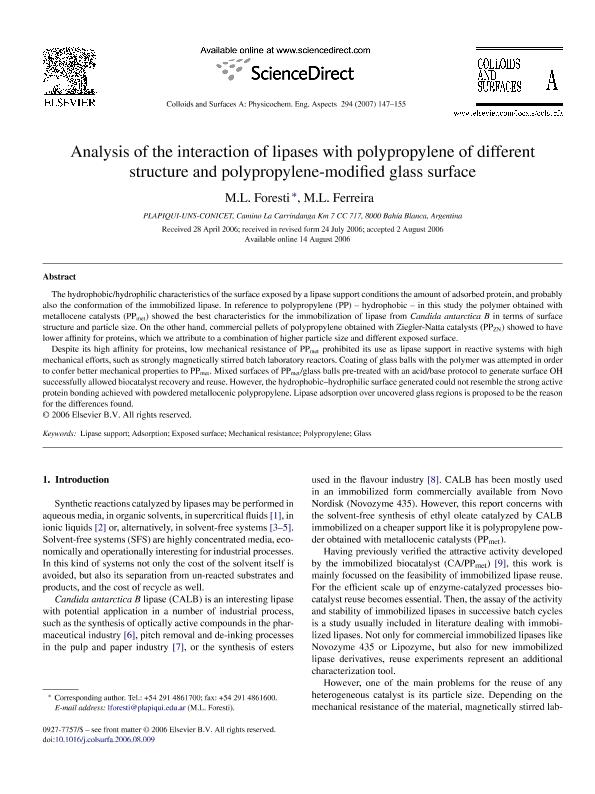Mostrar el registro sencillo del ítem
dc.contributor.author
Foresti, María Laura

dc.contributor.author
Ferreira, María Luján

dc.date.available
2018-08-10T17:48:20Z
dc.date.issued
2007-02
dc.identifier.citation
Foresti, María Laura; Ferreira, María Luján; Analysis of the interaction of lipases with polypropylene of different structure and polypropylene-modified glass surface; Elsevier Science; Colloids and Surfaces A: Physicochemical and Engineering Aspects; 294; 1-3; 2-2007; 147-155
dc.identifier.issn
0927-7757
dc.identifier.uri
http://hdl.handle.net/11336/54976
dc.description.abstract
The hydrophobic/hydrophilic characteristics of the surface exposed by a lipase support conditions the amount of adsorbed protein, and probably also the conformation of the immobilized lipase. In reference to polypropylene (PP) – hydrophobic – in this study the polymer obtained with metallocene catalysts (PPmet) showed the best characteristics for the immobilization of lipase from Candida antarctica B in terms of surface structure and particle size. On the other hand, commercial pellets of polypropylene obtained with Ziegler-Natta catalysts (PPZN) showed to have lower affinity for proteins, which we attribute to a combination of higher particle size and different exposed surface. Despite its high affinity for proteins, low mechanical resistance of PPmet prohibited its use as lipase support in reactive systems with high mechanical efforts, such as strongly magnetically stirred batch laboratory reactors. Coating of glass balls with the polymer was attempted in order to confer better mechanical properties to PPmet. Mixed surfaces of PPmet/glass balls pre-treated with an acid/base protocol to generate surface OH successfully allowed biocatalyst recovery and reuse. However, the hydrophobic–hydrophilic surface generated could not resemble the strong active protein bonding achieved with powdered metallocenic polypropylene. Lipase adsorption over uncovered glass regions is proposed to be the reason for the differences found.
dc.format
application/pdf
dc.language.iso
eng
dc.publisher
Elsevier Science

dc.rights
info:eu-repo/semantics/openAccess
dc.rights.uri
https://creativecommons.org/licenses/by-nc-nd/2.5/ar/
dc.subject
Adsorption
dc.subject
Exposed Surface
dc.subject
Glass
dc.subject
Lipase Support
dc.subject
Mechanical Resistance
dc.subject
Polypropylene
dc.subject.classification
Otras Ingeniería Química

dc.subject.classification
Ingeniería Química

dc.subject.classification
INGENIERÍAS Y TECNOLOGÍAS

dc.title
Analysis of the interaction of lipases with polypropylene of different structure and polypropylene-modified glass surface
dc.type
info:eu-repo/semantics/article
dc.type
info:ar-repo/semantics/artículo
dc.type
info:eu-repo/semantics/publishedVersion
dc.date.updated
2018-08-08T16:38:52Z
dc.journal.volume
294
dc.journal.number
1-3
dc.journal.pagination
147-155
dc.journal.pais
Países Bajos

dc.journal.ciudad
Amsterdam
dc.description.fil
Fil: Foresti, María Laura. Consejo Nacional de Investigaciones Científicas y Técnicas. Centro Científico Tecnológico Conicet - Bahía Blanca. Planta Piloto de Ingeniería Química. Universidad Nacional del Sur. Planta Piloto de Ingeniería Química; Argentina
dc.description.fil
Fil: Ferreira, María Luján. Consejo Nacional de Investigaciones Científicas y Técnicas. Centro Científico Tecnológico Conicet - Bahía Blanca. Planta Piloto de Ingeniería Química. Universidad Nacional del Sur. Planta Piloto de Ingeniería Química; Argentina
dc.journal.title
Colloids and Surfaces A: Physicochemical and Engineering Aspects

dc.relation.alternativeid
info:eu-repo/semantics/altIdentifier/doi/http://dx.doi.org/10.1016/j.colsurfa.2006.08.009
dc.relation.alternativeid
info:eu-repo/semantics/altIdentifier/url/https://www.sciencedirect.com/science/article/pii/S0927775706006182
Archivos asociados
